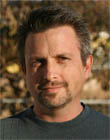|
|
This topic comprises 3 pages: 1 2 3
|
|
Author
|
Topic: Image resolution of 35mm cinema film
|
Richard Fowler
Film God

Posts: 2392
From: Ft. Lauderdale, FL, USA
Registered: Jun 2001
|
 posted 02-23-2004 11:55 AM
posted 02-23-2004 11:55 AM




The SMPTE Journal, February 2004 issue, has an article regarding film resolution in a theatrical setting.To paraphrase the seven page article, they shot a custom resolution chart using industry standard cameras with Kodak stock; made wet gate answer prints and normal negative, IP, dupe negative and release prints on different printers and release print stock.
In the negative stage the resolution was 2100L/Picture height, answer print = 1400L/PH, release print 1000L/PH. They projected the release prints in selected cinemas In the USA / Canada / France / Italy, the highest resolution was 875L/PH and the average was 715L/PH. In fairness they noted that higher resolution in the cinema is possible but they where looking for what today's filmgoers receive when they go to a typical, state of art, cinema.
| IP: Logged
|
|
|
|
|
|
|
|
|
|
|
|
|
|
|
|
|
|
|
|
|
|
|
|
|
|
|
|
John Pytlak
Film God

Posts: 9987
From: Rochester, NY 14650-1922
Registered: Jan 2000
|
 posted 02-23-2004 09:23 PM
posted 02-23-2004 09:23 PM





Steve Kraus wrote:
quote:
I tend to think that there is an integration over time which will penalize film projection for jitter in the projected image. It is my firm belief that human vision handles jitter without it penalizing the perceived resolution the way it does would if a camera photographs the screen and multiple frames in slightly different positions are combined into one for measuring purposes.
I agree. The eye / brain is very good at capturing the instantaneous fine detail, and perceiving the maximum sharpness. I have seen the high speed motion studies done almost 50 years ago by Kodak's Dr. Fred Kolb and more recently by the Kodak Enhanced Theatrical Experience team, and even in the presence of some jitter or focus instability, the human visual system compensates and captures the scene information. If it weren't so, even the real world would be a continual blur.
Much can be done to optimize the projection system, and it is certainly possible to get more than 80 line pairs per millimeter resolution on the screen. Likewise, printer slippage and the means of controlling it have been known since the days of Mssrs. Bell and Howell.
Steve is also right that there is more to perceived sharpness than simple resolution numbers. Kodak's Chuck Crane, Kelly Nelson, Bob Lamberts, and other researchers developed much of the science of measuring image sharpness using Modulation Transfer Function, and "cascaded" system MTF. They also developed sophisticated ways of quantifying perceived sharpness using weighting functions that were dependent on viewing distance (magnification) and human perceptual science.
| IP: Logged
|
|
|
|
All times are Central (GMT -6:00)
|
This topic comprises 3 pages: 1 2 3
|
Powered by Infopop Corporation
UBB.classicTM
6.3.1.2
The Film-Tech Forums are designed for various members related to the cinema industry to express their opinions, viewpoints and testimonials on various products, services and events based upon speculation, personal knowledge and factual information through use, therefore all views represented here allow no liability upon the publishers of this web site and the owners of said views assume no liability for any ill will resulting from these postings. The posts made here are for educational as well as entertainment purposes and as such anyone viewing this portion of the website must accept these views as statements of the author of that opinion
and agrees to release the authors from any and all liability.
|

 Home
Home
 Products
Products
 Store
Store
 Forum
Forum
 Warehouse
Warehouse
 Contact Us
Contact Us




 Printer-friendly view of this topic
Printer-friendly view of this topic








![[Wink]](wink.gif)








